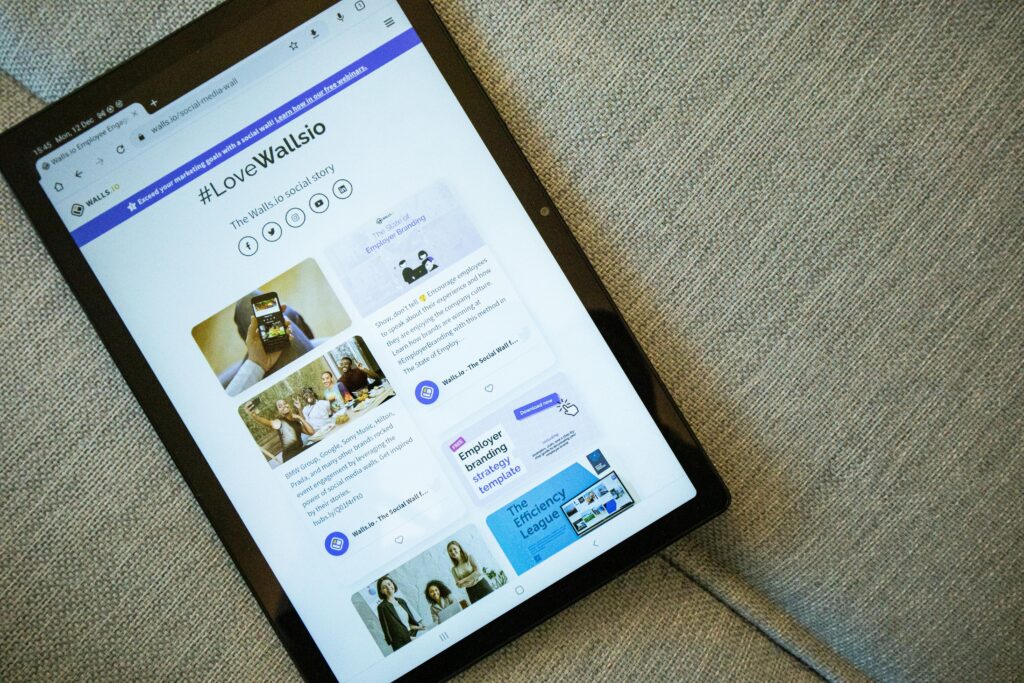From online shopping to training and education services, the way we connect with each other — and with companies — is changing rapidly.
But it’s not just the future that’s demanding better online experiences for customers. A website is already where potential customers go to learn about your services, understand your brand, and decide whether or not to engage with you.
And, of course, it’s a place for existing customers to keep coming back for more.
But, not every business has the resources to invest in a top-of-the-line website package right away, especially one with additional services like graphic design and SEO-optimised copy.
Instead, many startups and businesses under financial pressure find themselves turning to inexperienced web designers, or even going ‘DIY’ with a free website builder.
If this isn’t your cup of tea, though, what other low-cost website options are out there?
Web Design Strategy: Budget-Friendly Site Building
Serving as your online storefront, your website should represent the best of what your business has to offer. And, with 75% of people judging a business’s credibility based on its website design, it’s vital to get your website right from the start.
So, before investing time or money into a website you’ll have to fix later anyway, we suggest taking a closer look at your website goals and seeing if there are ways to communicate the value of your business without wasting money on a sub-par designer or tearing your hair out trying to do everything yourself.
One way of doing this is to focus on your main website pages first. Then turn your attention to inner pages with an optimisation strategy that won’t cost the earth.
Interested?
Here are our tips on how to get your website off the ground and create engaging and effective inner services pages, even on a budget!
1. Let Your Core Website Pages Set the Tone
When visitors land on your website, the core pages — your homepage, about page, and main service page — are the initial introduction to your business. If you clearly communicate your brand identity, core values, and primary product or service on your core pages, visitors will instantly know whether you’re the type of business they want to engage with or not.
Here’s what your core web pages should include:
- Clear and compelling homepage content: Use concise and engaging language to communicate your unique value proposition and guide visitors toward key actions. Your homepage is prime digital real estate, so be sure to make full use of it — just don’t overwhelm visitors with too much text or industry jargon. Keep it simple, strategic, and seamless to navigate.
- Informative about page: Give your website visitors an insight into your company’s history, mission, and values to establish credibility and trust with your audience. Use this space to showcase your team’s expertise and passion, giving visitors a reason to connect with your brand on a deeper level.
- Comprehensive service page: Clearly outline the range of services you offer, including detailed descriptions, benefits, and any unique selling points. Use this opportunity to address common pain points or challenges your target audience faces, demonstrating how your services can provide solutions and add value to their lives.
- User-friendly contact page: Make it easy for visitors to get in touch with you by providing a clear and easy-to-navigate contact page. Include essential information like your email address, phone number, and physical address (if applicable), along with a contact form for visitors to reach out directly.
After that, it’s all about using your other pages to nail down the finer details — and even filter down your audience — with highly-targeted content.
With less pressure on your inner services pages to communicate your broader brand message, we recommend using your inner services pages to:
- Provide detailed service descriptions: Use your inner services pages to provide comprehensive descriptions of each service you offer, including key features, benefits, and pricing information. This helps potential customers understand exactly what they can expect from your offerings and helps them make informed purchasing decisions.
- Reassure potential customers. Showcasing real-life examples and success stories of your company’s services helps build trust and credibility among your audience. This is why it’s a good idea to incorporate customer testimonials or case studies into your inner services pages, reassuring potential clients and encouraging them to engage with your business.

- Answer FAQs: Addressing common questions and concerns raised by customers directly on your services pages will save time for both you and your potential clients. Providing answers to frequently asked questions also helps alleviate doubts or uncertainties, streamlining the decision-making process and filtering out time-wasters.
- Enhance the user experience: Using visually appealing graphics or multimedia elements can help you convey essential information to your customers. And, with your homepage and other core pages already full of valuable brand content, inner services pages can be the perfect place to get a little more creative.
- Offer downloadable resources: Provide additional value to visitors by offering downloadable resources like ebooks or guides related to each service. These resources can not only help you capture valuable visitor information, it can also help position you as an industry leader.
Tip: If you’re using a cheap website builder to create your website, make sure you’re also taking website security into account. While the best cheap website builders claim to offer convenience and affordability, overlooking security measures can lead to significant challenges down the line. From a single web page to an entire website (and its associated data!), cheap website builders are often cheap for a reason. So mitigate the risk of cyber threats by doing your research first!

2. Use Conversion Copy for Your Inner Services Pages
If your website is the digital storefront of your business, then your inner services pages are the product shelves. A place where your visitors can truly get to grips with your offerings and decide whether or not to take action. So, your inner services pages need to give potential customers all the relevant information they need to feel good about connecting further with your business.
To ensure your inner services pages effectively convert visitors into customers, it’s important to focus on persuasive conversion copywriting techniques.
Whether it’s prompting them to make a purchase, sign up for a newsletter, or simply request more information, here are some conversion copy tips to keep in mind:
- Targeted and emotive messaging: Always tailor your copy to address the specific needs and pain points of your target audience, demonstrating how your services can solve their exact problems and add real value to their lives.
- Compelling headlines: Use attention-grabbing headlines that clearly communicate the value proposition of each service and entice users to learn more. The clearer you are about the value specific services offer, the more likely someone is to convert.
- Benefit-focused content: Highlight the benefits of your services rather than just listing features. This will emphasise the value proposition for the user and ensure the right audience connects with the best service for their needs.
- Customer testimonials: Make sure your copy is supported by customer testimonials or case studies. As mentioned earlier, showcasing real-life examples of your work can help build trust and credibility among your audience.
- Clear Calls-to-Action (CTAs): Include prominent and action-oriented CTAs that make it easy for users to take their next steps with you. Whether it’s scheduling a consultation, requesting a quote, or making a purchase — users that want to engage want to do it now!
- Process or ‘next steps’ information: Clearly outline the process or ‘next steps’ involved in engaging with your business, helping users understand what to expect after taking action. Whether it’s a step-by-step guide, an overview of the consultation process, or details about your service delivery, transparency is key to building trust and confidence in your offerings.
Tip: Don’t forget that conversion copy can also be used to guide potential customers from your social media platforms to a specific web page or landing page. By creating social media posts that focus on specific or niche services, you can advertise these services without bombarding certain segments of your social media audience with irrelevant content.
3. Strategically Incorporate SEO
Search Engine Optimisation (SEO) can significantly improve the online visibility and discoverability of your website. Unfortunately, there’s a misconception that in order for SEO to be effective, it has to be expensive.
While investing in a comprehensive SEO strategy is always advised, for those on a tight budget, it’s possible to boost your visibility without breaking the bank.
Inner services pages in particular can be optimised to contain targeted keywords and phrases that your potential customers are likely to search for. And, by strategically incorporating these relevant keywords into your page titles, headings, and body content, you can improve your chances of ranking higher in search engine results and attracting organic traffic to your site.

To maximise the impact of your SEO efforts on a budget, consider these cost-effective tactics:
- Keyword optimisation: As mentioned, relevant keywords are a good way to get your content noticed. And luckily, there are plenty of SEO tools and software (with free trials!) to help you find the best ones for your inner services pages. Once you’ve found the right keywords, it’s just a matter of strategically incorporating them throughout your web pages, from your page titles and URLs to your headings and body content.
- Internal linking: One effective and budget-friendly SEO tactic is internal linking, where you link between different pages on your website. By strategically linking relevant pages together, you can improve the flow of traffic throughout your site and help search engines better understand the structure and hierarchy of your content.
- Optimised meta tags: Another budget-friendly SEO strategy is optimising your meta tags, including meta titles and meta descriptions. These elements appear in search engine results and can greatly influence click-through rates. By crafting engaging and keyword-rich meta tags for your inner services pages, you can increase the likelihood of users clicking through to your site.
- Local SEO optimisation: If your business serves a specific geographic area, focusing on local SEO can be highly effective and cost-efficient. This involves optimising your website and content to appear in local search results, like Google Maps and local business listings. Make sure to include location-specific keywords in your inner services pages and create a Google Business Profile to boost your visibility in local searches.
- User experience optimisation: A good user experience now contributes to better SEO rankings. Focus on improving user experience by ensuring fast loading times, checking your site for mobile responsiveness, and keeping your navigation user-friendly.

4. Structure Your Web Pages for Optimal Performance
Whether you’re investing a lot in your website, or you’re trying to scrape through with minimum resources, the structure of your web pages can make a BIG difference to their performance.
A well-structured page does more than enhance the user experience and accessibility. It also helps search engines understand the relevance and hierarchy of your content, boosting SEO and helping your target audience find the exact pages they need — faster!
This is why, when working with a tight budget, it’s good to consider ‘quality over quantity’. Additional web pages can always be added later, but poorly-constructed ones can cause long-term damage to your brand!
To uphold best web design practices, we recommend only having live pages on your website that include:
- Clear & user-friendly hierarchy: Establish a clear hierarchy of information on each of your web pages using headings (H1, H2, etc.) to break up content and guide readers through the page.
- Strategically-placed CTAs: Strategically position Call-to-Action (CTA) buttons throughout the page to encourage user engagement and guide them towards desired actions.
- Concise paragraphs: Keep paragraphs short and concise to improve readability and keep users engaged.
- Visual elements: Incorporate visually-appealing images, videos, and infographics to complement textual content and enhance visitor understanding.
- Fast loading times: Optimise your web pages for speed by using efficient coding practices and leveraging browser caching to improve overall page load times. (This is particularly important if you’re using visual elements like large graphics or videos on your pages.)
- Mobile optimisation: Make sure that your pages are also optimised for mobile devices to cater to users accessing your website on smartphones and tablets.
- Internal linking: Include relevant internal links to other pages within your website to improve navigation and guide users to related content.
Tip: Accessible website content is also extremely important when it comes to industry best practices. For best results, consider everything from spacing and font type to accessibility features like alt text and keyboard navigation to make your content more accessible to all users.
5. Get to the Bottom of What Your Audience Wants to Know
Understanding your audience’s needs, preferences, and pain points is crucial for creating inner services pages that really contribute something special to your overall website. By conducting thorough research and analysis, you can uncover valuable insights that inform your content strategy and ensure that the time and money you do invest in these pages is worthwhile.
Here’s how you can get to the bottom of exactly what your audience wants to know:
- Conduct audience research: Start by identifying your target audience and conducting comprehensive research to gain insights into their demographics, behaviours, and preferences. Consider using tools like surveys, interviews, and social media analytics to gather data about their interests, challenges, and motivations. By understanding your audience’s needs and priorities, you can customise your inner services pages to provide more relevant and valuable information.

- Analyse keyword trends: SEO keywords aren’t just for boosting your search engine rankings, they can also be used to identify the most commonly searched queries related to your industry, products, and services. Pay attention to long-tail keywords and specific phrases that indicate user intent — these insights help you address the kinds of questions your audience is actively seeking answers to.
- Monitor social media conversations: Monitor social media platforms, online forums, and community groups relevant to your industry, listening to conversations and identifying recurring themes or topics. In particular, take note of the questions, comments, and feedback shared by your audience. Public forums can provide valuable guidance for creating content that converts.
- Analyse website analytics: Dive into your website analytics data to evaluate the performance of your existing content and user engagement metrics. Identify the pages that attract the most traffic, generate the highest conversions, and have the lowest bounce rates — helping you discover what kind of content is most relevant and valuable to your audience.
- Create a feedback loop: Encourage feedback from your audience by providing opportunities for them to share their thoughts, questions, and suggestions. Incorporate this feedback into your content strategy and continuously optimise your inner services pages based on user insights and preferences. By actively listening to your audience and adapting your content to meet their needs, you can create a more engaging and valuable experience that promotes trust and loyalty.

6. Use a Website Copywriting Template
Getting a handle on your website content can be tricky at the best of times, but trying to get it right the first time can be overwhelming. This is why it’s often a good idea to look for ways to streamline the content creation process, like creating copywriting templates.
These templates provide a structured framework for organising your content and ensuring consistency across your pages. From helping you get your headings in order to enhancing your storytelling and conversion copy techniques, the right copywriting templates can give you the ultimate headstart when it comes to crafting your inner services pages.
And, once you have a set of templates in place, you can use them again in the future, adding pages to your website as your business grows.
Here’s how to make the most of a copywriting template for your inner services pages:
- Fill-in-the-blank format: Use a ‘fill-in-the-blank’ format to guide your writing process, providing prompts and placeholders for essential elements like headlines, bullet points, and customer testimonials. Once you know what needs to be filled in, it’ll be easier to gather this information and present it in a way that aligns with your brand identity and target audience.
- Value proposition: As part of your copywriting template, be sure to include areas dedicated to highlighting your unique value proposition and key selling points for each service. This will help you emphasise how your offerings address customer needs and set you apart from competitors.
- Content outline: Start by outlining the key sections and subsections you want your inner services page to have. This can include a banner image and text, a clear introduction, individual service descriptions, pricing information, and strategically-placed CTAs.
- Editing and revision: Once you’ve filled in your template (or had someone else do it!), review and revise the content to ensure clarity, coherence, and consistency. Pay attention to tone, voice, and style to maintain a cohesive brand identity across your website. The great thing about templates is that you can add and remove sections as you see fit — so use your templates to see what works and what doesn’t. Sometimes, trial and error is the best way to go!
Looking for Pre-made, Performance-Driven Copywriting Templates?
Content Goodies Has You Covered!
Our Website Copywriting Accelerator Pack is designed to help businesses like yours create engaging, conversion-focused content without the hassle. With our ready-to-use templates, you can save time and effort while producing high-quality copy that connects with your audience and drives real results.
From telling you exactly where to place attention-grabbing headlines to instructing you on where to position persuasive call-to-action buttons, our pack includes a range of templates for various sections of your website, including homepage, about page, service pages, and more.
Each template is crafted by experienced copywriters and optimised for maximum impact, so you can trust that your content will engage visitors and encourage action.
Don’t let limited resources hold you back from creating exceptional website copy.
Get started with Content Goodies today and take your website to the next level!



